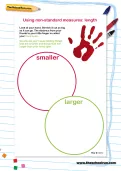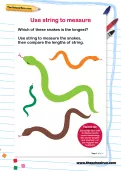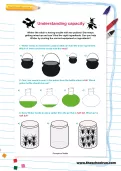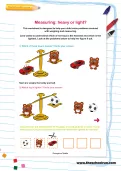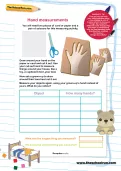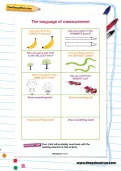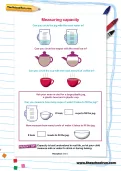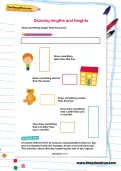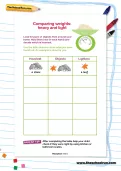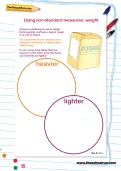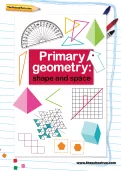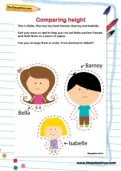Simple capacity word problems for Reception children.
or
Register to add to your saved resources
Already a subscriber? to view this content.
This activity is designed to help your child understand and use the vocabulary of distance and to practise solving practical problems.
or
Register to add to your saved resources
Already a subscriber? to view this content.
This worksheet is designed to help your Reception child solve first weighing and measuring problems.
or
Register to add to your saved resources
Already a subscriber? to view this content.
Mr Elephant wants to collect the heavier objects and his friend Miss Mouse wants to collect the lighter objects. Can you help them?
or
Register to add to your saved resources
Already a subscriber? to view this content.
Are you the tallest person in your family or the shortest? Are the items in your home taller or shorter than you? Let's do some measuring to find out!
or
Register to add to your saved resources
Draw around your hand on the paper or card and cut it out. Use your cut-out hand to measure things around your house, like a toy, a cupboard door, your bed. Now ask a grown-up to draw around their hand and cut it out. Measure your objects again, using your grown-up’s hand instead of yours. What do you notice?
or
Register to add to your saved resources
Already a subscriber? to view this content.
Can you find the longest, thinnest, tallest, smallest or widest? Then see if you can draw something long, thin, small and wide.
or
Register to add to your saved resources
Already a subscriber? to view this content.
Can you circle the jug with the most water in? Which teapot has more tea in it? Then get a large plastic jug of water and see if you can work out how many cups of water are in it.
or
Register to add to your saved resources
Already a subscriber? to view this content.
Can you draw something that is longer, shorter, taller or smaller than these objects?
or
Register to add to your saved resources
Already a subscriber? to view this content.
Look for pairs of objects from around your home. Hold them (one in each hand) and decide which is heaviest. Use the table below to show what you have found out.
or
Register to add to your saved resources
Already a subscriber? to view this content.
Let's get weighing! Choose something to use to weigh items against, perhaps a bag of sugar or a can of beans. Go around the house testing to see whether it is heavier or lighter than other things. In one circle draw items that are heavier; in the other draw the items you find that are lighter.
or
Register to add to your saved resources
Already a subscriber? to view this content.
Let's get measuring. Look at your hand. Stretch it out as big as it can go. The distance from your thumb to your little finger is called your hand span. Go around your house finding things that are smaller and things that are larger than your hand span. Write them in these circles.
or
Register to add to your saved resources
Let's have some fun with measuring height. Find the items listed and use them to measure the things around you (for example, draw something that is heavier than a can of beans). Why do you think we call this non-standard measuring?
or
Register to add to your saved resources
Already a subscriber? to view this content.
Do you know your hexagons from your heptagons, your pentagonal pyramids from your octagonal prisms? From 2D shapes to angles and symmetry our seventy-page Primary Geometry: shape and space learning pack covers all aspects of the national curriculum (Shape and Space) and will ensure your child can use a protractor, translate a shape and look for a mirror line. Challenge them to a game of 3D shape dominoes, make a right-angle measurer and get started!
or
Register to add to your saved resources
Already a subscriber? to view this content.
Add an extra learning dimension to family game time – try one of our Cool Maths board games and help reinforce your child's knowledge of number bonds, percentages and fractions while you play. Compiled by deputy headteacher Matt Revill and packed with 20 games, this maths learning pack covers all the key skills your child will need to master as part of the primary numeracy curriculum.
or
Register to add to your saved resources
Already a subscriber? to view this content.
Can your child compare different heights and pick the shortest or tallest person? Help them practise with this colourful worksheet, then try out their new skill on family members or stuffed toys.
or
Register to add to your saved resources
Already a subscriber? to view this content.
Long, short, tall and wide... Help your child use correct measurement vocabulary with this worksheet.
or
Register to add to your saved resources
Already a subscriber? to view this content.
This practical and fun activity will enable your child to measure the snakes with string and compare the lengths using mathematical language.
or
Register to add to your saved resources
